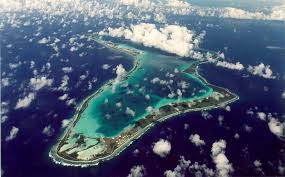First, they tried to shoot the dogs. Next, they tried to poison them with strychnine. When both failed as efficient killing methods, British government agents and U.S. Navy personnel used raw meat to lure the pets into a sealed shed. Locking them inside, they gassed the howling animals with exhaust piped in from U.S. military vehicles. Then, setting coconut husks ablaze, they burned the dogs’ carcasses as their owners were left to watch and ponder their own fate.
The truth about the U.S. military base on the British-controlled Indian Ocean island of Diego Garcia is often hard to believe. It would be easy enough to confuse the real story with fictional accounts of the island found in the Transformers movies, on the television series 24, and in Internet conspiracy theories about the disappearance of Malaysia Airlines flight MH370.
While the grim saga of Diego Garcia frequently reads like fiction, it has proven all too real for the people involved. It’s the story of a U.S. military base built on a series of real-life fictions told by U.S. and British officials over more than half a century. The central fiction is that the U.S. built its base on an “uninhabited” island. That was “true” only because the indigenous people were secretly exiled from the Chagos Archipelago when the base was built. Although their ancestors had lived there since the time of the American Revolution, Anglo-American officials decided, as one wrote, to “maintain the fiction that the inhabitants of Chagos [were] not a permanent or semi-permanent population,” but just “transient contract workers.” The same official summed up the situation bluntly: “We are able to make up the rules as we go along.”
And so they did: between 1968 and 1973, American officials conspired with their British colleagues to remove the Chagossians, carefully hiding their expulsion from Congress, Parliament, the U.N., and the media. During the deportations, British agents and members of a U.S. Navy construction battalion rounded up and killed all those pet dogs. Their owners were then deported to the western Indian Ocean islands of Mauritius and the Seychelles, 1,200 miles from their homeland, where they received no resettlement assistance. More than 40 years after their expulsion, Chagossians generally remain the poorest of the poor in their adopted lands, struggling to survive in places that outsiders know as exotic tourist destinations.
During the same period, Diego Garcia became a multi-billion-dollarNavy and Air Force base and a central node in U.S. military efforts tocontrol the Greater Middle East and its oil and natural gas supplies. The base, which few Americans are aware of, is more important strategically and more secretive than the U.S. naval base-cum-prison at Guantánamo Bay, Cuba. Unlike Guantánamo, no journalist has gotten more than aglimpse of Diego Garcia in more than 30 years. And yet, it has played akey role in waging the Gulf War, the 2003 invasion of Iraq, the U.S.-led war in Afghanistan, and the current bombing campaign against the Islamic State in Syria and Iraq.
Following years of reports that the base was a secret CIA “black site” for holding terrorist suspects and years of denials by U.S. and British officials, leaders on both sides of the Atlantic finally fessed up in 2008. “Contrary to earlier explicit assurances,” said Secretary of State for Foreign and Commonwealth Affairs David Miliband, Diego Garcia had indeed played at least some role in the CIA’s secret “rendition” program.

